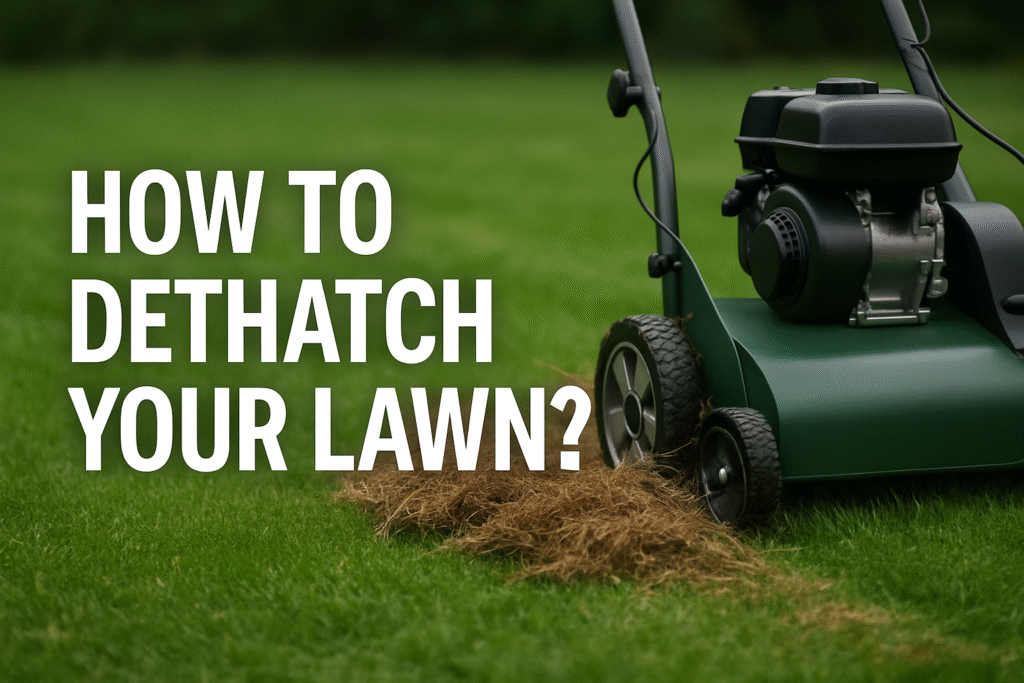Dethatching is a crucial part of keeping your lawn looking lush and green. Over time, grass, roots, and organic debris accumulate on the surface, forming a layer called “thatch. Some thatch is natural and even helps hold moisture. But too much can prevent important ingredients like air, water, and nutrients from reaching the soil. If that occurs, your lawn can become weak, yellow in spots, and generally less resistant. In this guide, we’ll show you how to dethatch a lawn, the process, and what keeps your lawn looking fabulous.
What is Dethatch Your Lawn?

Dethatch your lawn means to remove the dead grass layer and its related roots. While a small bit of thatch helps your grass, however, a thick layer can harm your lawn and make it more sensitive to turning brown. Even so, ensuring you dethatch your lawn at regular times will help keep it healthy and supply it with vital nutrients and water.
When to Dethatch Your Lawn
Thatching your lawn is best done when your grass is actively growing and can recover quickly. Early spring or early fall is best for cool-season grasses. However, late spring or early summer is a perfect time for warm-season grasses. Dethatch when the lawn is healthy and is not under stress, and when the weather is not overly dry or hot.
Pro tip: Measure the thickness of the thatch before deciding to dethatch. If the thatch layer is more than 1⁄2 inch thick, it’s time to act.
How Often to Dethatch Your Lawn
The frequency of dethatching is dependent on the grass type and the status of your lawn. Dethatching only needs to be done every 1-3 years on most lawns. Cool-season lawns may need dethatching every 2 years, and warm-season lawns every 1-2 years.
How to Dethatch Your Lawn

There are a few ways that you can go about dethatching your lawn, from manual tools to motorized dethatchers. The best option for you will depend on how large your lawn is, how much you have to spend, and how much effort you’re willing to put into the process.
How to Dethatch a Lawn Manually
When you have a small lawn and don’t mind getting a little dirty, dethatching your lawn manually is a good option. These techniques use a rake or a dethatching rake.
- Choose the Right Rake: A dethatching rake is an implement with sharp, curved tines that are slightly thicker than a regular lawn rake; the purpose of the tines is to pull the thatch in the lawn up. It is different from a standard rake, which cannot dig into the soil and rip out the thicker thatch layer.
- Rake the Lawn: Work in Small Sections of Your Lawn with the dethatching rake. Push the rake head into the grass, pull up, and then lift up the thatch. You might have to repeat a pass or two — it’s not the easiest task.
- Remove the Thatch: Now that you’ve raked up thatch, pile it up for disposal. You can compost the thatch, or you can bag it for disposal.
How to Dethatch a Lawn with a Rake
A standard rake won’t be as effective for dethatching your lawn as a dethatching rake, but it can still be done on small patches of grass or with thin thatch. It’s similar to, but more work than, using a dethatching rake.
Choose a Leaf Rake: Use a heavy-duty leaf rake with strong tines to lift some of the thatch from the grass.
Rake the Thatch: Kneel on the lawn and pull the rake through the grass in a crisscross motion, a few feet at a time, to lift the thatch.
Dispose of the Thatch: Rake up the thatch and dispose of it if required. Raking will remove the top layer of thatch and may not be as effective on a thick layer.
How to Use a Dethatched (Machine Method)
For larger lawns or more serious thatch issues, a dethatching machine (sometimes called a dethatcher or lawn dethatcher) can make the job a whole lot easier.
Rent or Buy a Dethatcher: If you don’t want to buy a dethatcher, you can rent one from a local home improvement store. They run blade or tine cylinders that turn and gouge out thatch from the soil.
Set the Dethatcher Depth: Adjust the dethatcher to the desired level. You want the tines to be able to sink through the thatch layer, but not into soil or grass roots.
Move Slowly and Steadily: Run the dethatcher straight, slightly overlapping in order. Go at the same speed for even dethatching.
Collect and Dispose of the Thatch: Once you finish dethatching with the dethatcher, gather the thatch and dispose of it just like you would if you used the manual method of dethatching.
Benefits of Dethatching Your Lawn
Dethatching your lawn is very helpful, as it supports grass health for months to come.
Enhanced Air Circulation: When you dethatch your lawn, you allow air to penetrate the soil which helps your lawn grow and stay healthy. The oxygen from fresh air supports the health of your plant’s root system.
Improved Water Penetration: That culture prevents water from reaching the soil in certain conditions. With the thatch gone, water seeps deeper into the ground, there is less surface runoff and your grass receives the necessary water. Thanks to this method, the lawn forms deeper roots and is better able to handle drought.
Strengthened Grass Growth: Because there is no thatch, grass seedlings can easily develop roots in the earth which results in better, stronger grass. A robust root system ensures a healthy, attractive and appealing lawn that nicely handles disease, insects, stress and drought.
Reduced Risk of Pests and Diseases: Too much thatch allows pests and diseases to thrive in your lawn. By removing thatch, you improve soil health as diseases and insects will not develop as well.
Dethatching as part of your lawn maintenance is a great way to maintain the health, appearance, and sustainability of your lawn.
Lawn Dethatching Tips

Successful dethatching and lawn care depend on the right practices. Here are some tips from the experts to make the best product:
Mow Before Dethatching: It is essential to mow the lawn 2 to 3 days before you dethatch. Cutting the grass will keep it from being too long while you do the dethatching work. The shorter grass will expose the thatch layer for better penetration of the dethatcher.
Water Before Dethatching: Watered one to two days before the dethatching job. This helps to loosen the soil. So dethatching is easier, and reducing the risks of hurting roots. The right soil moisture also optimizes the dethatcher’s effectiveness in digging into the thatch layer.
Use Proper Technique: When using a dethatching machine, adjust the depth settings correctly. This allows the tines to go into the thatch layer without damaging the grass roots or the soil beneath.
Rake and Clear Debris: After dethatching, be sure to rake up all the thatch debris. Remove organic matter like thatch from the lawn to keep it from interfering with drainage, and so your grass gets better air and water circulation.
When you follow these tips, you not only make your dethatching more effective, but you also ensure that your lawn remains healthier and more resistant to damage.
Conclusion
Dethatching your lawn is an essential aspect of lawn care to promote healthy grass. The process is more beneficial to your lawn’s air flow, water absorption, and overall lawn health. Dethatch at the right time and with the right tool to achieve the best results. Moreover, with regular dethatching and lawn care, your grass will stay green, healthy, and strong.
FAQs
Once there is more than ½ inch of thatch, you should dethatch your lawn. A simple way to test is to pull out a bit of grass and measure the thickness of the thatch.
No, it’s too stressful for the lawn in warm weather. Plant cool-season grasses in the early spring or fall and warm-season types in late spring to early summer.
Dethatching isn’t the same as aerating because dethatching means removing the thatch and aerating means putting holes in the soil. Each of these processes help the lawn, but they are not the same.
Yes, you can manually dethatch a lawn by using a specific dethatching rake but it takes a bit longer and is more labor-intensive. A power dethatcher is best for big lawns.
The price of renting a dethatcher can range from $30 to $60 per day for the size and type of equipment. It’s a great choice if you don’t plan to dethatch frequently.



